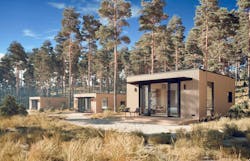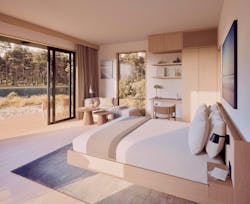Development startup brings modular solution to hospitality industry
By Quinn Purcell, Managing Editor
The hotel industry has long been dominated by major global corporations, making it difficult for newcomers to break into the field without significant financial resources and industry connections. However, building startup Tomu Inc. wants to change the landscape by offering an innovative and accessible solution: modular hotel units.
Tomu Inc., a sustainability-focused development startup that designs and builds prefabricated housing units, has started production of its luxury hotel units. The startup's modular system provides aspiring hoteliers with turnkey hotel units, akin to upscale tiny house hotel rooms, that are sustainable, affordable, and customizable to cater to various audiences, including underserved travelers. Chris Osaka, CEO of Tomu Inc., emphasizes the company's mission to empower a more diverse range of hosts and hoteliers.
“Our sustainable modular hotel units save money and time, while providing the individual owner a realistic opportunity to enter into the hospitality industry," says Osaka. The CEO underscores that Tomu can bring concepts to life, from design to delivery, within a few months.
Building Customized Modular Hotel Units
The company's approach extends to various types of accommodations, from landscape hotels and cozy bed and breakfasts to compact micro hotels and food and wine-themed properties. Tomu's selling point lies in its proprietary prefab hotel units, which allow property owners to design their rooms with different aesthetics to target specific customer segments.
The process involves selecting a prefab unit shell from Tomu and working closely with a design team to fully customize the physical elements and desired design parameters. The company offers three levels of unit configuration:
- Ready To Stay: Tomu's line of detached guest units, known as the Villa Collection, come in studio, one-, and two-bedroom floor plans—all designed in a distinctive Tomu aesthetic. The Villa Collection caters to the evolving preferences of modern travelers, suitable for both short weekend getaways and longer stays.
- Made To Suit: Developer clients have the option to customize configurations of Tomu's Villa Collection to align with project requirements. The startup collaborates with developers to tailor amenities to match the project's unique concept.
- Fully Bespoke: Rather than maintaining Tomu's signature material palette and fixtures, this configuration gives clients full design control.
To support their vision, Tomu recently acquired a 15,000-sf production facility at the Hagerstown Regional Airport in Hagerstown, Md., in order to expand manufacturing capabilities and production by Q4 2023. Learn more about Tomu Inc. on the company's website.


